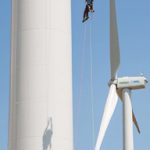Onshore wind energy in Eastern Europe, Russia, and the Caspian will experience a compound annual growth rate of 9 percent from 2018 to 2027, according to new research by Wood Mackenzie Power & Renewables. The latest Eastern Europe Onshore Wind Market Outlook 2018 reports 16 GW of new onshore wind capacity that will be added in the region over the next 10 years.
“The development will be largely driven by the implementation of auction schemes in Russia and Kazakhstan and proposed auctions in Poland and Ukraine,” said lead author Sohaib Malik, market analyst.
Wind-power auctions have fast become a favored policy tool of Eastern European countries as they follow a global trend of moving away from feed-in tariff (FIT). In other markets globally, such auctions have led rapid growth, with Brazil and Saudi Arabia being only two examples.
“Poland will be picking back up as a dominant market in the region soon after the enactment of favorable amendments introduced to the renewable energy act in July 2018, which will allow the previously permitted, but halted, wind projects to participate in auctions,” Malik said. “This development gives a major boost to the Polish onshore wind market.”
A maturing wind project pipeline in Russia, Ukraine, and Kazakhstan will support the medium-term market outlook. Russia will experience immense growth between 2021 and 2024 as developers are required to connect most of the 3.2 GW of awarded capacity during this period. Ukraine, on the other hand, will have transitioned from the feed-in tariff (FIT) regime to auctions by the end of 2019, which will create more competition between developers to help reduce the cost of wind power.
“We expect significant coal decommissioning in Hungary, Poland, and Romania after 2020 due mainly to an ageing fleet and stricter emissions regulations,” Malik said. “As wind power becomes more competitive due to reductions in technology costs and environmental benefits, it will be in a strong position to displace this coal power capacity in EU member states across the region.”
In the future, an interplay of continued growth in those leading regional markets, as well as the emergence of small, new wind markets such as Armenia, Azerbaijan, Georgia, and Slovakia, will ensure long-term growth prospects.
“Traditionally, a rather small region where developers added 142 MW of new wind capacity in 2017 in three markets, Eastern Europe will grow by more than twofold over the next 10 years,” Malik said.
Only regulatory uncertainty poses a risk to this positive forecast, which can be mitigated by proactive measures by the relevant governments. To ensure that awarded wind power capacity is ultimately commissioned, governments in Eastern Europe will have to streamline permitting and grid integration regulations.
More info www.woodmac.com

































